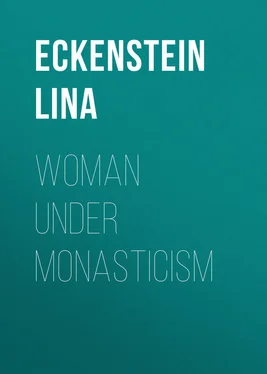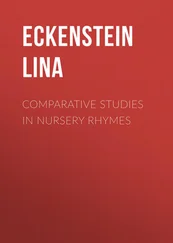Lina Eckenstein - Woman under Monasticism
Здесь есть возможность читать онлайн «Lina Eckenstein - Woman under Monasticism» — ознакомительный отрывок электронной книги совершенно бесплатно, а после прочтения отрывка купить полную версию. В некоторых случаях можно слушать аудио, скачать через торрент в формате fb2 и присутствует краткое содержание. Жанр: История, foreign_antique, foreign_prose, на английском языке. Описание произведения, (предисловие) а так же отзывы посетителей доступны на портале библиотеки ЛибКат.
- Название:Woman under Monasticism
- Автор:
- Жанр:
- Год:неизвестен
- ISBN:нет данных
- Рейтинг книги:4 / 5. Голосов: 1
-
Избранное:Добавить в избранное
- Отзывы:
-
Ваша оценка:
- 80
- 1
- 2
- 3
- 4
- 5
Woman under Monasticism: краткое содержание, описание и аннотация
Предлагаем к чтению аннотацию, описание, краткое содержание или предисловие (зависит от того, что написал сам автор книги «Woman under Monasticism»). Если вы не нашли необходимую информацию о книге — напишите в комментариях, мы постараемся отыскать её.
Woman under Monasticism — читать онлайн ознакомительный отрывок
Ниже представлен текст книги, разбитый по страницам. Система сохранения места последней прочитанной страницы, позволяет с удобством читать онлайн бесплатно книгу «Woman under Monasticism», без необходимости каждый раз заново искать на чём Вы остановились. Поставьте закладку, и сможете в любой момент перейти на страницу, на которой закончили чтение.
Интервал:
Закладка:
The legend of Pharaildis gives no clue to the Christian interest in her, nor to the veneration of her, which is localised at Ghent, Hamm, Steenockerzeel, and Loo. We hear that she was married against her inclination, that she cured her husband who was a huntsman of a wound, and that after his death she dwelt in solitude to an advanced age, and that occasionally she wrought miracles. Further, in popular belief, she crossed the water dryshod, she chased away geese from the corn, and she struck the ground and the holy fountain at Bruay welled up for the benefit of the harvesters – incidents which are not peculiar to her legend. The festival of Pharaildis is kept on different dates at Ghent, Cambray, Maastricht and Breda. At Ghent it is associated with a celebrated fair, the occasion for great rejoicings among the populace. At the church of Steenockerzeel stones of conical shape are kept which are carried round the altar on her festival 42 42 Wauters, A., Histoire des environs de Bruxelles , 1852, vol. 3, pp. 111, 123 ff.
, in the same way as stones are kept elsewhere and considered by some writers to be symbols of an ancient phallic cult. The legend explains the presence of these stones by telling how the saint one day was surreptitiously giving loaves to the poor, when her act would have been discovered but that by intercession the loaves were transformed into stones. This incident, the transformation of gifts secretly given to the poor, is introduced into the legends of other women-saints, but only in this case have I found it mentioned that the transformed food was preserved. We shall have occasion to return to Pharaildis, whose legend and cult offer nothing to support the view that she was an early Christian.
There are numerous instances of a like connection between holy missionary and woman pseudo-saint. A fair example is yielded by Leodgar (St Léger) bishop of Autun († 678), a well-defined historical personality 43 43 A. SS. Boll. , Vita St Leodgarii, Oct. 2.
, whom tradition makes into a near relative of Odilia, a saint widely venerated, but whose reputed foundation of the monastery on the Hohenburg modern criticism utterly discards 44 44 Roth, K. L., ‘St Odilienberg’ in Alsatia , 1856, pp. 91 ff.
.
But it is not only Christian missionaries who are associated with these women-saints. Quite a number of saints have been brought into connection with the house of the Karlings, and frequently Karl the Great himself figures in the stories told of them. I do not presume to decide whether the legendary accounts of these women are pure invention; some historic truth may be embodied in the stories told of them. But judging by the material at hand we are justified in disputing the existence of St Ida, who is said to have been the wife of Pippin of Landen and ancestress of the Karlings on the sole authority of the life of St Gertrud, her daughter. This work was long held to be contemporary, but its earliest date is now admitted to be the 11th century 45 45 Bonnell, H. E., Anfänge des karolingischen Hauses , 1866, pp. 51, 149 etc. It is noticeable that another woman-saint Ida ( A. SS. Boll. , St Ida, June 20) figures as ancestral mother of the Liudolfings, who became kings in Saxony and emperors of Germany, comp. Waitz, Jahrbücher des deutschen Reichs unter Heinrich I. 1863, Nachtrag I.
. It is less easy to cast discredit on the existence of the saints Amalberga, the one a virgin saint, the other a widow, whom hagiologists find great difficulty in distinguishing. Pharaildis, mentioned above, and the saints Ermelindis, Reinildis and Gudila, are said to be Amalberga’s daughters, but together with other saints of Hainault and Brabant they are very obviously pseudo-saints. The idea of bringing Karl the Great into some relation with them may have arisen from a twofold desire to justify traditions concerning them and to magnify the Emperor’s importance.
In this connection it seems worth while to quote the passage in which Grimm 46 46 Grimm, J., Deutsche Mythologie , 1875, p. 207.
describes the characteristic traits of the German goddess in his German Mythology, and to consider how these traits are more or less pronounced in the women we have called pseudo-saints.
‘It seems well,’ he says, in the opening of his chapter on goddesses, ‘to treat of goddesses collectively as well as individually, since a common conception underlies them all, which will thus stand out the more clearly. They are conceived essentially as divine mothers, travelling about and visiting mortals , from whom mankind learn the ways and arts of housekeeping and tilth: spinning , weaving , guarding the hearth , sowing and reaping ’ (the italics are his).
The tendency of the goddess to wander from place to place is reflected in many women pseudo-saints who are represented in their legends as inhabiting at various periods of their lives different parts of the district in which they are the object of veneration. Verena of northern Switzerland dwelt first at Solothurn, where a cave, which was her dwelling-place, is now transformed into a chapel. Later she took boat to the place where the Aar, Reuss and Limmat meet, where she dwelt in solitude, and her memory is preserved at a spot called the cell of Verena (Verenazell). Later still she went to dwell at Zurzach, a place which was celebrated for a fair, called Verena’s fair, of which more anon. All these places are on or near the river Aar, at no inconsiderable distance from each other. The legend, as told by Stadler, takes them all into account, explaining how Verena came to be connected with each 47 47 Stadler und Heim, Vollständiges Heiligenlexicon , 1858-82.
.
Similarly the legend of the saint Odilia 48 48 Lebensgeschichte der heil. Othilia. Freiburg, 1852.
, referred to above in connection with the Hohenburg, explains how the saint comes to be worshipped on both sides of the Rhine, a cruel father having driven her away from home. On the eastern side of the river there is a hill of St Odilia, Odilienberg, where there is a fountain which for its healing powers is visited twice a year and the site of which is guarded by a hermit. At Scherweiler there is also a site hallowed to her worship, and local tradition explains that she stayed there as a child; according to another version she was discovered floating in a wooden chest on the water 49 49 Alsatia , 1858-60, p. 268, contains local stories.
. Finally she is said to have settled on the Hohenburg west of the Rhine and to have founded a monastery. The critic Roth has written an admirable article on Odilia and the monastery of Hohenburg. He shows that the monastery was ancient and that at first it was dedicated to Christ and St Peter, though afterwards their names were supplanted by that of St Odilia 50 50 Roth, K. L., ‘St Odilienberg’ in Alsatia , 1856, p. 95.
. Here, as on the other side of the Rhine, the folk celebrate her festival by pilgrimages to a fountain which has miraculous healing power, and by giving reverence to a sacred stone, on which Odilia is said to have knelt so long in prayer for the soul of her wicked father, that her knees wore holes in it 51 51 Menzel, Christliche Symbolik , article ‘Knieen.’
.
We hear that other saints travelled about and stayed now at one place, now at another. St Notburg visited different parts of the Neckar district 52 52 Du Bois de Beauchesne, Madame Ste Notburg , 1888, pp. 85, 197 etc. Stadler und Heim, Vollständiges Heiligenlexicon , and A. SS. Boll. so far, omit her.
, Godeleva of Ghistelles 53 53 Lefebure, F. A., Ste Godeleine et son culte , 1888. A. SS. Boll. , St Godelewa, July 6.
passed some time of her life in the marshy district between Ostend and Bruges. This Godeleva is addressed in her litany as the saint of marriage; she was buried, we are told, in a cave, which was held holy as late as the present century. The pond, into which she was thrown after death, for which act no reason is given, obtained, and still retains, miraculous healing powers 54 54 Wonderlyk Leven. Cortryk 1800, anon., pp. 42, 45 etc.
. Her legend in other respects offers the usual traits. She is Godeleva in some parts of the country; in others she is Godeleina, and her life according to Potthast was written in the 11th century by Drago, a monk of Ghistelles.
Интервал:
Закладка:
Похожие книги на «Woman under Monasticism»
Представляем Вашему вниманию похожие книги на «Woman under Monasticism» списком для выбора. Мы отобрали схожую по названию и смыслу литературу в надежде предоставить читателям больше вариантов отыскать новые, интересные, ещё непрочитанные произведения.
Обсуждение, отзывы о книге «Woman under Monasticism» и просто собственные мнения читателей. Оставьте ваши комментарии, напишите, что Вы думаете о произведении, его смысле или главных героях. Укажите что конкретно понравилось, а что нет, и почему Вы так считаете.












